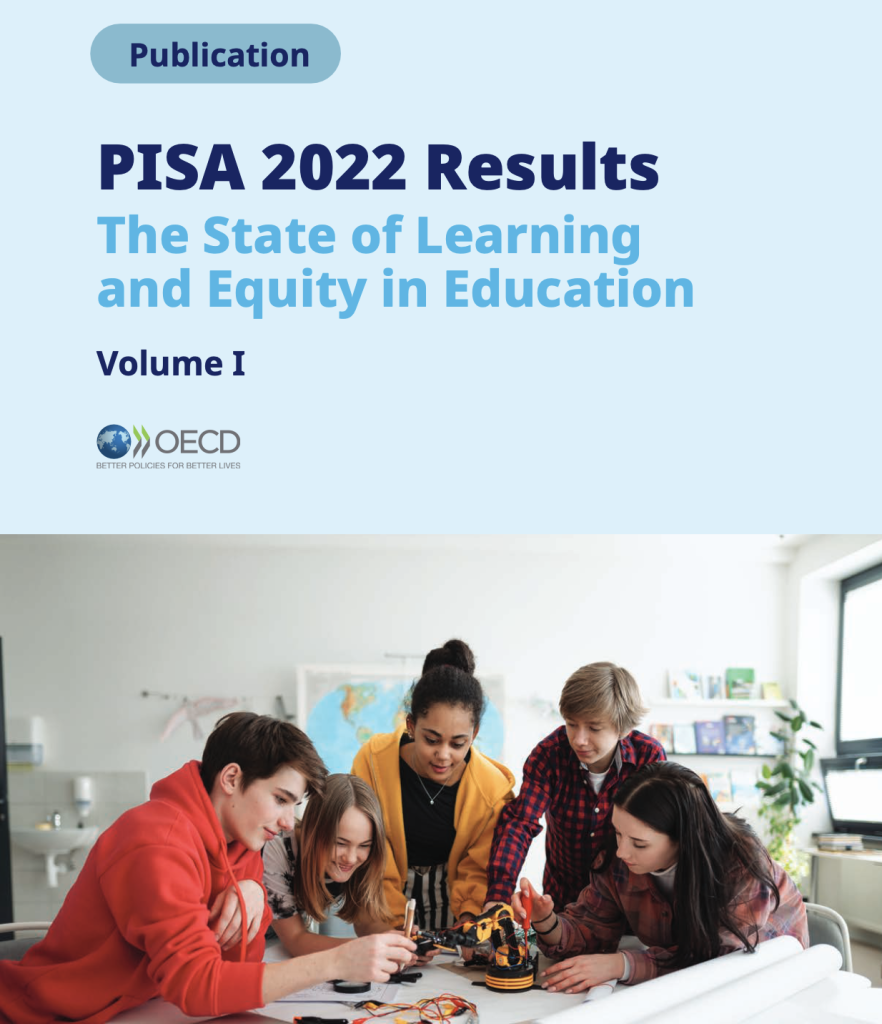“All international assessment data like this is a starting point for discussion, though people tend to use it as an end point.”
Professor Christian Bokhove, in TES article, ‘UK’s PISA scores fall in maths, science and reading’
It is difficult for a busy school teacher or leader to process legions of headlines about international education data like those generated by the PISA tests (the OECD’s ‘Programme for International Student Assessment‘) taken by teenagers across the world. You can dig into a wealth of data and reporting (SEE HERE – with an England specific analysis HERE), but here are some of my quick reflections that may be of interest and help discussions in schools that go beyond the headlines.
- The pandemic hit hard internationally. PISA 2022 scores saw an “unprecedented drop in performance” – Compared to 2018, mean scores fell by 10 points in reading and by almost 15 points in maths, which is equivalent to three-quarters of a year’s worth of learning. Not all the drop can be accounted for by the pandemic – some countries bucked the trend and were successful (e.g. Korea, Japan and Switzerland), while others were already on a downward trend before the pandemic.
- England’s teens saw test scores drop, but ultimately they improved in international comparisons. English pupils scored 492 in maths (down from 504 in 2018), which is significantly above the 472 OECD average. That makes us 11th in the world in maths! In reading, English pupils scored 496 (down from 505 in 2018), which is significantly above the 485 OECD average. In science, English pupils scored 503, (down from 505 in 2018), but once more a lot higher than the 485 OECD average. (For context, some experts argue scores that change +/- 10 points are worth noting).
- Maths attainment is a positive for English teens. The move up the league table in maths indicates a significant positive trend (much higher than our neighbours in Wales and Scotland). English teens achieved some of the best scores in mathematical reasoning. We don’t quite know why, but curriculum changes makes sense as one cause (including the English maths curriculum being a bit more like the PISA tests).
- The disadvantage gap doesn’t appear to be worsening (although there is still a significant gap)*. In terms of socio-economic status, the gap between the most advantaged pupils and the least advantaged was reduced marginally. For example, in maths the gap between the two groups was 85 points compared to the OECD average of 93; in reading it was 82 instead of 93. There needs to be more caution about these results though, because the England analysis from Oxford University shows that the population tested had higher academic attainment on average and a lower proportion of pupils who have been eligible for FSM for the past 6 years. [*Not very confident making this claim]
- Too many children in England and the UK don’t know where their next meal is coming from. 1 in 10 UK 15-year-olds (11%) replied in a PISA survey that they had missed meals because of lack of money/poverty. It places the UK on a par with countries such as Mexico and Moldova. Utterly grim. No analysis needed; just action.
- Teacher and staff shortages are hurting the English education system. The top barrier to progress cited by Headteachers in England is “teacher shortages”a lack of teaching staff” – coming out at 46% in England, compared to 53% in the OECD. Additionally, 80% of heads cited “inadequate or poorly qualified teaching staff as a problem”, compared to 74% at the OECD average. It is no surprise, given national figures have been poor for a while, that recruitment and retention is a focus for schools and the government. It is an international problem too however.
- Immigration enriches the English education system. Immigration is a hot topic, but we need to dig beneath the shouty newspaper headlines, as PISA data reveals that second generation immigrants do better than non-immigrant students (first generation do marginally worse but only by a little). For all children, particularly in comprehensive schools, this means second generation immigrants are doing great and help raise the tide for all pupils.
- Wales and Scotland have some issues. Trends in maths see Scotland and Wales make significant drops when compared to England. Reading scores in England and Scotland are far better than Wales – whose broad picture is pretty grim. See these handy graphs shared on an X thread by Luke Sibieta HERE.
- PISA data has issues and data from England is incomplete. There are undoubtedly positive trends we should celebrate from PISA 2022. Schools do a brilliant job and there have been some positive policies, whilst there has been some mitigations of the damage wrought by the global pandemic. That said, around one in three schools and one in four pupils overall refused to take part in the study. As a result, it is estimated results could be inflated by as much as 8 or 9 points (whilst the Spring exam sitting in English was 6 months later than many other countries. CAUTION KLAXON…boring, I know.
The OECD does a good, transparent job of sharing lots of data, so expect lots more news based on this round of reporting. I’ll be looking to the likes of FFT Education Datalab for more PISA insights in the near future. If you fancy, you can even take some PISA 2022 test questions HERE.
